Joe lvl 3 Media Blog
Wednesday, 25 September 2019
Saturday, 1 June 2019
Unit 21 Bibliography
1899 'A Kiss in the Tunnel'
https://www.youtube.com/watch?v=6vdb79xXMWg
https://www.youtube.com/watch?v=6vdb79xXMWg
Louis LePrince 'Traffic Crossing Leeds Bridge'
https://www.youtube.com/watch?v=wTlXaqG4VyE
William Freise Greene Bobliography
http://www.screenonline.org.uk/people/id/508948/index.html
No Country for old men Hotel Room Scene
https://www.youtube.com/watch?v=wTlXaqG4VyE
William Freise Greene Bobliography
http://www.screenonline.org.uk/people/id/508948/index.html
No Country for old men Hotel Room Scene
Following the action
Following the action Fast and Furious car chase
The Master Field Escape scene
Building suspense
Breaking bad Granite state Suspense
2001 A Space Odyssey jump cut transition
Toy story, Buzz tries to jump out of window
Drifters 1929
The godfather church scene
Unit 21: Film Editing (Understanding the techniques and applications of editing for film and television)
William Frieze-Greene had taken up photography and was a camera salesman, inventing some of his own; he attempted to create moving pictures, however his invention, with a turning handle that would capture the images on film, could only run u p to around 5-6 images.
The Lumiere Brothers had created the process of dry plate developing for film images. They were also responsible for starting of taking a motion picture that at the time could only be seen for one person for a view finder, and instead plant the image onto a screen, where it could be seen by many more people at the same time.
The first edited film, where they cut from an exterior shot to an interior shot, or move positions of the camera and show a different shot, was made in 1899 called 'The Kiss In The Tunnel', before this film, creators would film one shot until either the film reel ran out, or if the operator got bored, this film was the first to change area and position, splicing them together, changing film making and creating the process that is now editing.
 The Moviola machine, made by Iwan Serrurier (1924) was able to offer a way to view the film whilst editing, this made the process of cutting, splicing etc. more convenient. You could let the film run it's intentional way, 24 frames per second, or could push pedals to move the film forward or backward by a frame, giving a more specific frame.
The Moviola machine, made by Iwan Serrurier (1924) was able to offer a way to view the film whilst editing, this made the process of cutting, splicing etc. more convenient. You could let the film run it's intentional way, 24 frames per second, or could push pedals to move the film forward or backward by a frame, giving a more specific frame.
In present day, anyone is able to edit their own movies, being able to use free software that comes with their computers such as Movie-Maker and Filmora. Premiere Pro and Final Cut style software's offers a much faster way of editing with streamline access to filters, transitions and many more effects. Gone are the days of hiring a crew or buying product to develop the image and have professionals edit it, we now live in a time where you can sit at home, on your sofa and edit.
Types and purpose of editing film and television
Editing a sequence together, and assembling them in an order that create a chronological structure, when something is edited after another event, it is implied that event did actually happen after the other such as if we saw a man rob a train and shoot someone, we would expect him to do so in that order, this is a style of editing that is known as continuity editing.
If a scene includes a dream sequence or a memory, something that builds away from the line of order, that would be breaking the continuity and making non-continuity editing.
Purpose of editing for film and television
Manipulating a clips time speeds up or slows down the clips. a clip could do this to fix the pace at post, getting a clips point across quicker or it could be used to add or heighten an intentional reaction. A film that uses slow motion to express the reaction to the audience whilst giving them more time to process the meaning behind the edit can be found scattered through Raging Bull, the film also must present a few decades in a couple hours, this means that the film must flash forward through time, only taking the most relevant stages/ points of his life, a show/ film could also use flashbacks, giving details or reminders to previous or unshown parts of the story. A shot reverse shot and eye-line match has the ability and expectation to create space between both shots, giving you the understanding of the distance between the subject and the other object/ person without having to have them in the same shot. Controlling the pace or rhythm of editing, if done well, should seem seamless, invisible editing helps control the flow on the scenes.
Functions of editing for film and television
-Create Narrative
Motivated editing has the ability to further the narrative. As the shot ends and another is presented, it is assumed that the story progresses, motivated editing that moves the story could be something such as a eye-line match and shot reverse shot, where we now know what the character was looking at off screen. 'No Country for Old Men' (2007) is able to created motivated editing, it shows the eye line match of the handle of the door flying off the door, cutting to the characters reaction and then back to the shot of the door, having the character shoot the door closed, editing that is motivated to progress the narrative forward. It also creates a development of drama, introducing the stakes of the situation, a hidden tracking device and then bringing in the antagonist of the film into the scene. This scene in the hotel room withhold information, having you question the well being of the outside characters and whether danger is correct and if our protagonist will make it out alive, the entire hotel section stays in the room, questioning the outer situations. The creators were able to provide information, showing us a blinking tracker, we hear a beeping receiver on the other end of the door, signaling that the person who planted it, the one who wants the money back, is the real character and isn't a fake out moment.
-creating continuity between shots
Changing location to interior or exterior, normally at the beginning, involves an establishing shot which helps the viewer understand where the scene will be taking place. In order to keep continuity, if one character is going from one place to another, time must change, if the location between are far away, it may change from day to night or a different day. If two people share a house together and one person is shown in the living room and then cuts to the other in the kitchen, it keeps continuity of location keeps within the same house. If a character is leaving, show them in the parking lot or garage, getting into their car and leaving showing progression in the characters location and in the story. The master is able to change location and have us understand the length of travel without having to show us, we can understand the contrast of location from a sparse population to larger civilization. The Master is also able to change the time frame with the field escape scene, it changes from day to night, making the scene destroying the events occurring in real time. You could also change the time frame with something such as a dream sequence, it sends the story into a different place and time, pedaling off from the story being told to deliver a persons new story whilst they are asleep.
-Create audience reaction and engage the viewer.
Building suspense in film and television is one of the best ways in order to grab and engage the audience, building up to their reaction, suspense must keep within a pace, this pace must slowly intriguing the audience, therefore longer shots of substantial elements of the scene must be established and drawn out,; once this is done, introduce the threat of for the protagonist, this will be made up of shorter edits, keeping shots fresh and not expiring the image, using shorter shots means that the audience has no breathing time, it creates a fast pace editing style that keeps the audiences engagement, soon the payoff is brought to the viewer, this offer the audiences reaction and normally stays on the smallest amount of shots, slowing the scene back down in terms of editing. A television show that is able to achieve a suspenseful reaction as well as keeping to the pace that builds this is 'Breaking Bad', during the bar scene in the penultimate episode 'Granite State' this scene builds around the music, introducing a tense engagement, building it up with more instruments and a faster pace and then onto the payoff.
-Create meaning
Applications of editing techniques
 Establishing shots are a way to introduce the audience into a new setting. It progresses the narrative forward and is a helpful message to the viewer that the story has changed location. It is usually used for the beginning of a scene and can be done with only one shot.
Establishing shots are a way to introduce the audience into a new setting. It progresses the narrative forward and is a helpful message to the viewer that the story has changed location. It is usually used for the beginning of a scene and can be done with only one shot. Cut-away's are a good way of avoiding jump cuts and is a way to introduce or remind the existence of outside, unimportant elements of the scene. A cut away starts with the focus/ subject, cuts away to something else such as a television or flower, and then cuts back to the original focus, keeping continuity in the scene.
Cut-away's are a good way of avoiding jump cuts and is a way to introduce or remind the existence of outside, unimportant elements of the scene. A cut away starts with the focus/ subject, cuts away to something else such as a television or flower, and then cuts back to the original focus, keeping continuity in the scene. The 30- Degree rule is a way to avoid making your different shots look like jump cuts, it's a rule that builds upon the premise that if you cut between a shot or place different amounts of cameras, it's to ensure that when one shot is established, to not directly cut to a different shot within 30 degrees of the original shot.
The 30- Degree rule is a way to avoid making your different shots look like jump cuts, it's a rule that builds upon the premise that if you cut between a shot or place different amounts of cameras, it's to ensure that when one shot is established, to not directly cut to a different shot within 30 degrees of the original shot.Jump cutting are taking two shots in a row and having very small distinctions between both of them. It makes it look like a passage of time and makes the product look amateur.
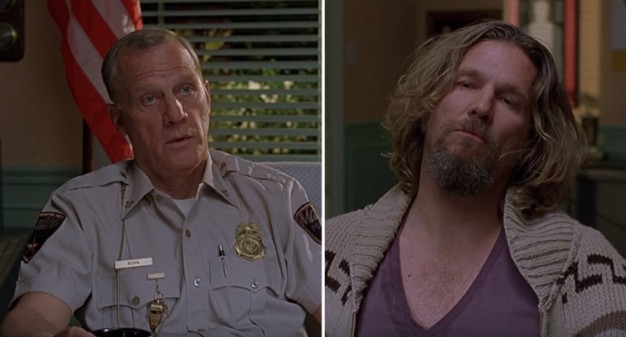 Shot/reverse shot are normally used during conversation and consists of showing one subject and cutting to another flipped with where they are looking and the camera placement.
Shot/reverse shot are normally used during conversation and consists of showing one subject and cutting to another flipped with where they are looking and the camera placement.
The 180 degree rule is the invisible line that builds around the premise that you when you are placing the camera, to not cut to a point of the room the other way, imagine a circle around the subject, you shouldn't take the first shot that begins at one point of the circle and then the second shot that is on the opposite site, 180 degrees away from it. This rule tends to be broken to give a dizzy effect on the audience as the positions of the characters or objects are completely flipped.
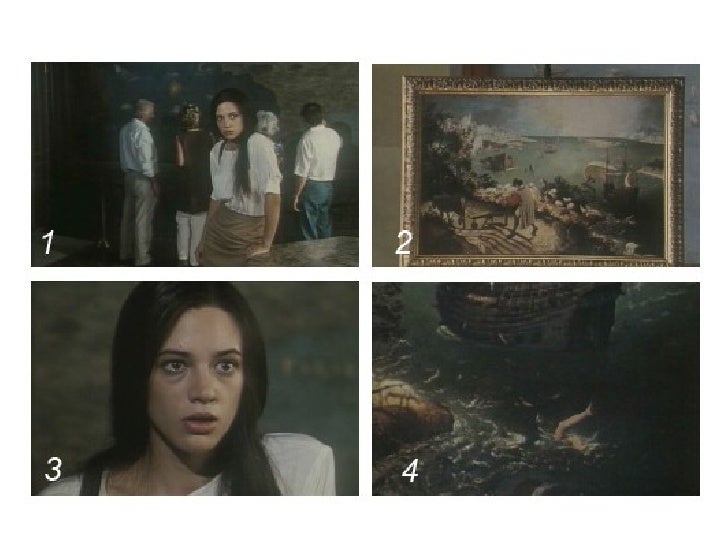 Eye-line match is an editing rule that if you show a character looking at something off of the screen, what the audience cannot see, they will immediately become interested at what they are looking at, bringing the characters and viewers focus towards that ambiguous subject, then you must establish what that focus was, making the next cut after that the thing the character was previously focused on. It has been used so much, the audience tends to expect the next shot to be what the characters are looking at whether we know this rule or not.
Eye-line match is an editing rule that if you show a character looking at something off of the screen, what the audience cannot see, they will immediately become interested at what they are looking at, bringing the characters and viewers focus towards that ambiguous subject, then you must establish what that focus was, making the next cut after that the thing the character was previously focused on. It has been used so much, the audience tends to expect the next shot to be what the characters are looking at whether we know this rule or not.
Match cuts is taking something that is shown in a specific area of the frame and having a look alike or exact subject ripped from that area and into the next, it could show the character changing location. In the first shot, it has us focus on a specific area of the screen and having it cut to the next shot changing the it slightly but using something that looks like it or exactly that.
Seamless editing occurs when the editors have been able to edit the scene together in a pace that flows through each shot without lingering on any shot too long or cutting short at any point, you can take the a shot, go back to it and everything stays the same in the background, the person is wearing the same shirt, the cup has the same amount of drink in it etc. and nothing is out of the ordinary and not distracting. When hard work occurs in editing, it should go unnoticed.
Montage's are a way to show large progression in the narrative whilst taking as little amount of time as possible.
Juxtaposition is taking two subjects that contrast largely and have them connect either due to a theme, similarity or large difference such as black and white are complete difference but are both colors.
Freeze-framing is choosing a specific frame of the film and staying on it for more that 1/24th the amount of time/ the actual time it should be shown. This became a popular editing technique during the 80's where they would end their films on a specific frame. This trick stops the film entirely, keeping the object/ character in one position and freezing time, bringing the audience captivation away from the film intentionally.
Slow motion is an editing technique of taking a shot or combination of shots and slowing the time down, heightening the overall run time, it can be used to keep focus on an intentional point of the story however can bring the viewer away from the captivation of the film, making it a distraction.
 Split screen is used to cut the shots in half and planting another next to/ above it. This technique removes the need to cut to causes and reactions and instead contains both within the frame. It takes up less time however removes the illusion of film. A film such as requiem for a dream uses it at the beginning to express that they both have equal ground and foreshadows that both, emotionally, will end up in the same place by the end of the film.
Split screen is used to cut the shots in half and planting another next to/ above it. This technique removes the need to cut to causes and reactions and instead contains both within the frame. It takes up less time however removes the illusion of film. A film such as requiem for a dream uses it at the beginning to express that they both have equal ground and foreshadows that both, emotionally, will end up in the same place by the end of the film.Wipes are a transition best used to change locations instead of between characters and objects in a scene. It is a way to end the scene and cut to the next that has large distance between the last. It became a popular transition in the franchise Star Wars.
Dissolves and fades are a slower transition to another shot. It is a way to linger on the shot whilst introducing another. It could be used to introduce or end the film.
Thursday, 4 April 2019
500 word Keyboard analysis
I had used the plus and minus symbols on the keyboard, to
thicken the sound and visuals bar; using this, I was able to easily change the
volume and be able to have a smoother and less jarring ascending and descending
and introduction to new diegetic and non-diegetic sounds. I used the arrow keys
up and down to change between the next/ previous clips, being able to keep
track of the pacing and the next cuts, and in case something needed changes to
it. I used left and right of the arrow keys to specifically pin to each frame,
I did this so that I could accurately understand when to use sounds for
specific moments in the project also a way to cut a clip before a new angle is
introduced or delete a cigarette burn that informs a new shot. I used the M key
a few times to add markers to specific points, coming back to them in later
times and know specifically where the points should be used. The C key was a
way for me to easily change to cutting up clips, not having to search for the
razor tool, streamlining the process of cutting and editing parts; I changed
between the hand and razor tool the most, the hand tool being H, this way I could
drop clips into specific points in the timeline without editing the clips
themselves. I used the square brackets to easily increase or decrease volumes
to specific sounds, having the desired effect from each sound due to what
should be the loudest at each point. I used the comma key to insert clips into
the timeline. The space bar was a way to easily and quickly stop and start the
timeline. Throughout the process, the workload would be too large for Premiere
to properly play the project, because of this, it meant that I would have to
render at points, having a smoother replay, I used the enter/ return key to
render throughout the project, an efficient way to have an easier understanding
of what the clips would actually look like. I had used the backslash key to
quickly look at the overall timeline and using the mouse the quickly jump from
one clip to another when editing or dragging in new clips to fit the previous
shot. Using the copy and paste [CTRL C and CTRL V] would create an identical
version of the clip that I would already have, I could test the image such as
lowering it’s opacity without having to step backwards [CTRL Z] instead just
deleting the clip by highlighting the clip with the D key, highlighting the
clip that the playhead would be on.
Assingment 2 Task 1 Car Chase proof
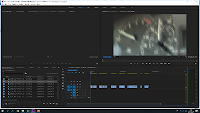
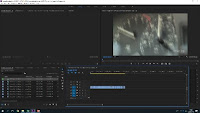
I edited the clips mainly according to the editing decision list, earlier made. I deleted all the irrelevant and unusable footage scattered throughout each recording, having around 5 minutes of usable footage; after which, I grouped them together within a beginning, middle and ending structure, knowing all the clips that I would use and build sounds according to what would be shown on screen.
The loud car
rev was obvious at the beginning, then as soon as I was introducing other
sounds at the beginning, I lowered the volume scale after the beginning few
seconds of the engine starting.
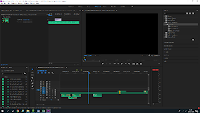 Due to no footage of the backstory of the car chase, I
had assembled different sound effects for there to be a reason. I brought in a
person running from the left side to the right, connoting to that being the
person that would be driving the vehicle, I used alarm bells and gunshots;
however, due to this taking place outside and the rest of the footage built
around this red car, I had the sounds be taken place from the perspective of
inside the car, I used a lowpass on all of the sounds and as the car door
opens, I set all the sounds such as the ambiance and alarm bells to normal
effect and as it closes again, it would be set back to its original state of
lowpass.
Due to no footage of the backstory of the car chase, I
had assembled different sound effects for there to be a reason. I brought in a
person running from the left side to the right, connoting to that being the
person that would be driving the vehicle, I used alarm bells and gunshots;
however, due to this taking place outside and the rest of the footage built
around this red car, I had the sounds be taken place from the perspective of
inside the car, I used a lowpass on all of the sounds and as the car door
opens, I set all the sounds such as the ambiance and alarm bells to normal
effect and as it closes again, it would be set back to its original state of
lowpass.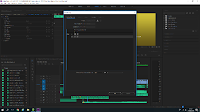 At the beginning of the chase after
the crime, I had faint police sirens come from the one side of the speakers/
headphones, giving a sense of the further surroundings after establishing the
local area and actions. As the camera cuts to the car speeding through the
road, I have the car come from both sides, this way it feels like that both
cars are now on the same road and that the police car has been able to gain
shorter ground between the car we see, adding tension to the scene.
At the beginning of the chase after
the crime, I had faint police sirens come from the one side of the speakers/
headphones, giving a sense of the further surroundings after establishing the
local area and actions. As the camera cuts to the car speeding through the
road, I have the car come from both sides, this way it feels like that both
cars are now on the same road and that the police car has been able to gain
shorter ground between the car we see, adding tension to the scene. 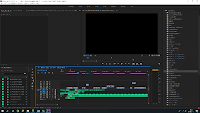 I added diegetic music to fill empty space between
there being not many sound effects occurring, this adds depth to the amount of
sounds used for each moment throughout the scene whilst having the wanted mood.
I added diegetic music to fill empty space between
there being not many sound effects occurring, this adds depth to the amount of
sounds used for each moment throughout the scene whilst having the wanted mood.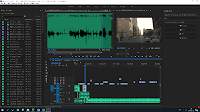 The car radio was changed from the previously mentioned diegetic music into
car radio static, this reveals that the music that was heard was happening in
the world and that the character has manipulation around their surroundings,
the radio is more powerful on the right side, however not being so noticeable
that it distracts the viewer from it only happening from one side, it was on
the right side due to the radio placed on the characters ride side of them
driving on the left area of the car, where most of the static heard from the
character would be coming from. I had also done this
slightly to the second song ‘sinnerman’, this again would add to the realism of
the scene whilst not being distracting to the viewer.
The car radio was changed from the previously mentioned diegetic music into
car radio static, this reveals that the music that was heard was happening in
the world and that the character has manipulation around their surroundings,
the radio is more powerful on the right side, however not being so noticeable
that it distracts the viewer from it only happening from one side, it was on
the right side due to the radio placed on the characters ride side of them
driving on the left area of the car, where most of the static heard from the
character would be coming from. I had also done this
slightly to the second song ‘sinnerman’, this again would add to the realism of
the scene whilst not being distracting to the viewer.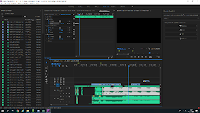 I
had gradually lower the volume of the police sirens as the car was distancing
from the police, this would add realism and awareness to the situation. I also
had added low pass to the siren whenever the shot would be from inside the car,
whenever a shot from outside of the car was shown, I would heighten the volume
of the siren, lower the volume of the music slightly and remove the lowpass to
the siren.
I
had gradually lower the volume of the police sirens as the car was distancing
from the police, this would add realism and awareness to the situation. I also
had added low pass to the siren whenever the shot would be from inside the car,
whenever a shot from outside of the car was shown, I would heighten the volume
of the siren, lower the volume of the music slightly and remove the lowpass to
the siren.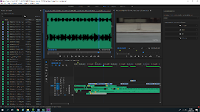 As the police car is shown
on screen for one shot, I would have a quieter version of the siren and pick up
volume whenever it would get close to the camera, I also had engine and tire sounds come from slightly to the left and as the car drove away from the camera,
on the opposite end, it would come from the right, keeping a clear rule and
continuity throughout the shot.
As the police car is shown
on screen for one shot, I would have a quieter version of the siren and pick up
volume whenever it would get close to the camera, I also had engine and tire sounds come from slightly to the left and as the car drove away from the camera,
on the opposite end, it would come from the right, keeping a clear rule and
continuity throughout the shot.
The
car, coming from the right side of the screen starts more powerful on the right
side and progresses through to leveling out between both sides, left and right.
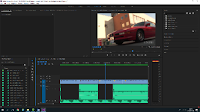 The interior of the car contrasts with the exterior shots and surroundings. The engine between outside
and inside shots are different and the outside engine becomes more clear and
the inside having a more vibration like sound quality to it, however, the sound
that stays the same throughout each types of these shots is the music, being
able to be contained in the same way throughout this scene and not to irritate
or distract the viewer from the music playing, or else the changes throughout each point would become too noticeable to someone.
The interior of the car contrasts with the exterior shots and surroundings. The engine between outside
and inside shots are different and the outside engine becomes more clear and
the inside having a more vibration like sound quality to it, however, the sound
that stays the same throughout each types of these shots is the music, being
able to be contained in the same way throughout this scene and not to irritate
or distract the viewer from the music playing, or else the changes throughout each point would become too noticeable to someone. 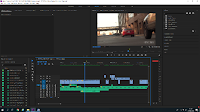 During the shot that a grey
car and it’s tire can be seen, I had that be the dominant motor, having a
larger truck like sound effect around the right side of the speakers, reinforcing the visuals, and as the red car starts to center the screen, so
does the audio.
During the shot that a grey
car and it’s tire can be seen, I had that be the dominant motor, having a
larger truck like sound effect around the right side of the speakers, reinforcing the visuals, and as the red car starts to center the screen, so
does the audio.
As
the character puts their foot down further on the pedal, I have increased the
volume of the internal engine, raising intensity and keeping continuity,
matching the visuals.
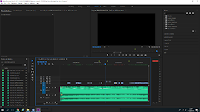 Introducing the helicopter, I had the propeller noise coming from the
left, further understanding the surroundings and then slowly coming neutral, at
this point we can realize it’s chasing the protagonist and that it has probably
found them. To raise the power of the helicopter and the magnitude of the
problem, I decided to not use any additional deigetic sounds meaning they're no
distractions. I also cut apart clips to imitate the helicopter and choppy
decision making. The only sounds besides the helicopter was a piece of music
that panned from left to right.
Introducing the helicopter, I had the propeller noise coming from the
left, further understanding the surroundings and then slowly coming neutral, at
this point we can realize it’s chasing the protagonist and that it has probably
found them. To raise the power of the helicopter and the magnitude of the
problem, I decided to not use any additional deigetic sounds meaning they're no
distractions. I also cut apart clips to imitate the helicopter and choppy
decision making. The only sounds besides the helicopter was a piece of music
that panned from left to right.
I also varied the volume of
the helicopter by pinning points of the helicopters timeline and lowering them
gradually, for people not to pick up on what is happening, however might being
able to understand distance is closing and opening between the car and chopper.
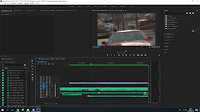 I cut apart some of the
music to keep the theme of the helicopter, in different places keeping the
sporadic attitude to the closing section. I added sounds back into the scene, symbolizing the act of coming back to reality, the car engine driving toward
and away from the camera was from central to left, the way the visuals had shown
it.
I cut apart some of the
music to keep the theme of the helicopter, in different places keeping the
sporadic attitude to the closing section. I added sounds back into the scene, symbolizing the act of coming back to reality, the car engine driving toward
and away from the camera was from central to left, the way the visuals had shown
it. Thursday, 21 March 2019
Friday, 25 January 2019
Unit 24 Assignment 1 task 1
Unit 24 Sound Editing
Task 1
Assignment 1
Compressing and summarizing sounds to fit to what the media is presenting can be shown through trailers. The reason they would do this is either that the song is too long, and they would have to choose specific parts of the song to support the film, or create a new meaning to the song entirely. A good way to see this in effect would be from Gapar Noe's Climax trailer:
https://www.youtube.com/watch?v=gNp0jlfbgqM
This trailer continues a loop of a specific part of the song to match the hyper mood of the film.
The actual song is less active after this specific part:
https://www.youtube.com/watch?v=cJ5V3OZdIZM
The reason they would choose this part instead of another is one because it wants to match the mood and another is because the original song has lyrics. If you were to use the lyrics, this would distract from the films dialogue and make certain parts of the trailer less effective. The use of this part of the song creates a repetitive chaos, a selling point of the films and narrative and directors reputation. Using the ending of the song means that the trailer has a justified reason to end and a fitting conclusion, if it were to end abruptly it could distract the viewer and cut away it's momentum.
Eliminating flawed, repetitive, uninteresting or irrelevant material from recorded clips, this would occur mainly to highlight a specific area and/ or take away parts of the whole product that doesn't present as significant quality to the rest. The Joe Rogan Experience, a podcast, includes full interviews with celebrities, whilst clipping specific parts of the interviews into easily consumable portions. An example of this is when Joe Rogan invited Elon Musk to the podcast.
https://www.youtube.com/watch?v=ycPr5-27vSI
However, because of its large length, they have taken small amounts of the interview and made them into more easily and specific parts.
https://www.youtube.com/watch?v=HfqtKPP2_6M
This part shows Elon Musk with his flamethrower idea, a part that was of higher quality, and has became a highlight from the interview/ podcast. The reason they would do this is because people wouldn't normally want to sit through a long interview and rather watch the best bits, an easier and quicker way to understand the height of the interviews.
Keeping recorded speech legal may be to keep it safe for television limits, or any shows that censor themselves. If any swearing, nudity or any other adult content is revealed during the show, they would have to remove it. an example of this was when Ricky Gervais swore during the Golden Globes
https://www.youtube.com/watch?v=j71bDdVbjp4
They had to remove the audio from that part of the program to remain legal and keep a family friendly rating. It is a global awards ceremony that occurs annually, and due to a need to target towards families to ground this further into a tradition, they have to target and popularize to each household, meaning that they will have to remove any adult related content.
Taking out any inappropriate language or incident from a product usually is done because of the fact that younger audiences may watch it due to its availability. Vevo does this to music videos for YoutTube and earlier companies achieved the same effect for places such as MTV.
https://www.youtube.com/watch?v=gOMhN-hfMtY
This music video by Eminem presents a censored version of the original song. Due to inappropriate language the censoring company take away the layer of audio or entire part of the song and send it off the be broadcasted on the radio and TV. Another reason they would censor a product is to be able to show adult content during day time television. Trailers are known to remove language, content etc. from trailers in order to have it green banned.
https://www.youtube.com/watch?v=7kSuas6mRpk
Kill Bill had tinted the colour of the scenes to make the blood blacker and look less like blood, any swearing hadn't been included and a lot of the violence isn't shown. Doing this ensures that they will be able to have a green band trailer and is able to be seen by all audiences. One incident that didn't manage to be edited out and changed TV was the John F Kennedy assassination.
https://www.youtube.com/watch?v=Ie5XMXZvB_Y
This content was one of the first harsh content to be shown on TV and had changed TV because of their firm grasp on censorship. Censoring the language or actions is used to make the product legal to be broadcasted to radios and TV's during the day, making it more available to other people and has a higher chance of it being heard by people. Not censoring content means that it can only be shown after Watershed, where more adult content is allowed.
Changing the chronological order of sound/ speech has been used throughout trailers, they intend to do this to either confuse the viewer and/ or drip feed them enough information about the film that it peeks their interest, which, if not in order, offers them a different idea of the film, subverting their expectations. A trailer such as The Handmaiden
https://www.youtube.com/watch?v=whldChqCsYk
is able to present the footage in a disorderly way which makes the spectator question the article, furthering the interest and obsession of the film. The film would not play these sound effects in order throughout the film, it wouldn't have people breathing in and out then a chair falling. they limit the amount of sounds to engage the audience, keeping them aware, offering an active viewing.
On the other hand, a film such as Amour
https://www.youtube.com/watch?v=F7D-Y3T0XFA
is able to use dialogue to explain the tones, genre and events of the film, it reveals personality in the characters we are going to be spending the trailer and the film with. You can understand by their accent and pitch that they are French and either male or female. The film has music playing over the trailer, by the end of it, the music is cut out by a button, this means that there won't be conversations and days turning into nights as this one piece of music playing at this speed will be throughout these events of the movie, instead they change the order and the amount of sounds in the trailer, feeding you a lot about the film by only using a little.
Both pieces show that you can change the order pieces of sounds to create a brand new interpretation of an entire source or become interested into wanting to learn more about it. These pieces are used to grab your attention, pick apart the pieces of sounds and try and fit them together to make an understanding that seems right for the film, it makes you an active listener.
Adding sound effects and soundtracks/songs during moments of recorded speech can make an easy impact on the audience and through a small clip, could be able to understand what sort of film the genre fits into. Adding songs into dietetic existence of the film during a tense moment can make the film feel like a comedy, such as Shaun of the Dead during the bar scene.
https://www.youtube.com/watch?v=W4tVH7BPb-Q&t=62s
This scene creates a danger and introduces a light heart, upbeat rock song, this cuts into conversation between the characters and would have had to have been layered on top of the recorded footage to make it sound more cinematic, this provides contrapuntal sound between the music played and the characters situation and the danger they are faced with.
Using sound effects when cutting off characters dialogue mid sentence can also be used in a dramatic way, Synecdoche New York during it's ending scene has the main character Caiden talking to another actress, and as he is going through his sentence, a voice over commanding script queues from him commands him to die, distant shouting and screaming matches the tone of the scene and supports the visual effect of the scene. It establishes distant action, bringing what is near us lower in urgency and a slower atmosphere. The music is parallel to what is being shown, high strings to evoke a sad emotion to reinforce what is being shown.
https://www.youtube.com/watch?v=Y0j3xN5UWDY
This is scene is used to provoke sadness from the viewer, used in a drama film.
Although I have shown how music can be used as a comedic way of cutting off dialogue and sound effects/ voice overs can be used to cut off dialogue for drama, they both can be used vice versa and outside the emotion of comedy and sadness, it's just the way you use them and the context of it's use.
Task 1
Assignment 1
Compressing and summarizing sounds to fit to what the media is presenting can be shown through trailers. The reason they would do this is either that the song is too long, and they would have to choose specific parts of the song to support the film, or create a new meaning to the song entirely. A good way to see this in effect would be from Gapar Noe's Climax trailer:
https://www.youtube.com/watch?v=gNp0jlfbgqM
This trailer continues a loop of a specific part of the song to match the hyper mood of the film.
The actual song is less active after this specific part:
https://www.youtube.com/watch?v=cJ5V3OZdIZM
The reason they would choose this part instead of another is one because it wants to match the mood and another is because the original song has lyrics. If you were to use the lyrics, this would distract from the films dialogue and make certain parts of the trailer less effective. The use of this part of the song creates a repetitive chaos, a selling point of the films and narrative and directors reputation. Using the ending of the song means that the trailer has a justified reason to end and a fitting conclusion, if it were to end abruptly it could distract the viewer and cut away it's momentum.
Eliminating flawed, repetitive, uninteresting or irrelevant material from recorded clips, this would occur mainly to highlight a specific area and/ or take away parts of the whole product that doesn't present as significant quality to the rest. The Joe Rogan Experience, a podcast, includes full interviews with celebrities, whilst clipping specific parts of the interviews into easily consumable portions. An example of this is when Joe Rogan invited Elon Musk to the podcast.
https://www.youtube.com/watch?v=ycPr5-27vSI
However, because of its large length, they have taken small amounts of the interview and made them into more easily and specific parts.
https://www.youtube.com/watch?v=HfqtKPP2_6M
This part shows Elon Musk with his flamethrower idea, a part that was of higher quality, and has became a highlight from the interview/ podcast. The reason they would do this is because people wouldn't normally want to sit through a long interview and rather watch the best bits, an easier and quicker way to understand the height of the interviews.
Keeping recorded speech legal may be to keep it safe for television limits, or any shows that censor themselves. If any swearing, nudity or any other adult content is revealed during the show, they would have to remove it. an example of this was when Ricky Gervais swore during the Golden Globes
https://www.youtube.com/watch?v=j71bDdVbjp4
They had to remove the audio from that part of the program to remain legal and keep a family friendly rating. It is a global awards ceremony that occurs annually, and due to a need to target towards families to ground this further into a tradition, they have to target and popularize to each household, meaning that they will have to remove any adult related content.
Taking out any inappropriate language or incident from a product usually is done because of the fact that younger audiences may watch it due to its availability. Vevo does this to music videos for YoutTube and earlier companies achieved the same effect for places such as MTV.
https://www.youtube.com/watch?v=gOMhN-hfMtY
This music video by Eminem presents a censored version of the original song. Due to inappropriate language the censoring company take away the layer of audio or entire part of the song and send it off the be broadcasted on the radio and TV. Another reason they would censor a product is to be able to show adult content during day time television. Trailers are known to remove language, content etc. from trailers in order to have it green banned.
https://www.youtube.com/watch?v=7kSuas6mRpk
Kill Bill had tinted the colour of the scenes to make the blood blacker and look less like blood, any swearing hadn't been included and a lot of the violence isn't shown. Doing this ensures that they will be able to have a green band trailer and is able to be seen by all audiences. One incident that didn't manage to be edited out and changed TV was the John F Kennedy assassination.
https://www.youtube.com/watch?v=Ie5XMXZvB_Y
This content was one of the first harsh content to be shown on TV and had changed TV because of their firm grasp on censorship. Censoring the language or actions is used to make the product legal to be broadcasted to radios and TV's during the day, making it more available to other people and has a higher chance of it being heard by people. Not censoring content means that it can only be shown after Watershed, where more adult content is allowed.
Changing the chronological order of sound/ speech has been used throughout trailers, they intend to do this to either confuse the viewer and/ or drip feed them enough information about the film that it peeks their interest, which, if not in order, offers them a different idea of the film, subverting their expectations. A trailer such as The Handmaiden
https://www.youtube.com/watch?v=whldChqCsYk
is able to present the footage in a disorderly way which makes the spectator question the article, furthering the interest and obsession of the film. The film would not play these sound effects in order throughout the film, it wouldn't have people breathing in and out then a chair falling. they limit the amount of sounds to engage the audience, keeping them aware, offering an active viewing.
On the other hand, a film such as Amour
https://www.youtube.com/watch?v=F7D-Y3T0XFA
is able to use dialogue to explain the tones, genre and events of the film, it reveals personality in the characters we are going to be spending the trailer and the film with. You can understand by their accent and pitch that they are French and either male or female. The film has music playing over the trailer, by the end of it, the music is cut out by a button, this means that there won't be conversations and days turning into nights as this one piece of music playing at this speed will be throughout these events of the movie, instead they change the order and the amount of sounds in the trailer, feeding you a lot about the film by only using a little.
Both pieces show that you can change the order pieces of sounds to create a brand new interpretation of an entire source or become interested into wanting to learn more about it. These pieces are used to grab your attention, pick apart the pieces of sounds and try and fit them together to make an understanding that seems right for the film, it makes you an active listener.
Adding sound effects and soundtracks/songs during moments of recorded speech can make an easy impact on the audience and through a small clip, could be able to understand what sort of film the genre fits into. Adding songs into dietetic existence of the film during a tense moment can make the film feel like a comedy, such as Shaun of the Dead during the bar scene.
https://www.youtube.com/watch?v=W4tVH7BPb-Q&t=62s
This scene creates a danger and introduces a light heart, upbeat rock song, this cuts into conversation between the characters and would have had to have been layered on top of the recorded footage to make it sound more cinematic, this provides contrapuntal sound between the music played and the characters situation and the danger they are faced with.
Using sound effects when cutting off characters dialogue mid sentence can also be used in a dramatic way, Synecdoche New York during it's ending scene has the main character Caiden talking to another actress, and as he is going through his sentence, a voice over commanding script queues from him commands him to die, distant shouting and screaming matches the tone of the scene and supports the visual effect of the scene. It establishes distant action, bringing what is near us lower in urgency and a slower atmosphere. The music is parallel to what is being shown, high strings to evoke a sad emotion to reinforce what is being shown.
https://www.youtube.com/watch?v=Y0j3xN5UWDY
This is scene is used to provoke sadness from the viewer, used in a drama film.
Although I have shown how music can be used as a comedic way of cutting off dialogue and sound effects/ voice overs can be used to cut off dialogue for drama, they both can be used vice versa and outside the emotion of comedy and sadness, it's just the way you use them and the context of it's use.
Subscribe to:
Comments (Atom)



